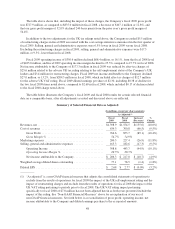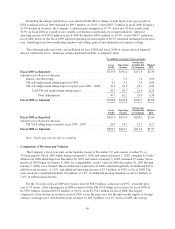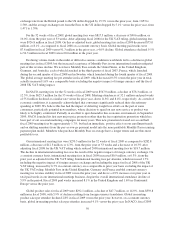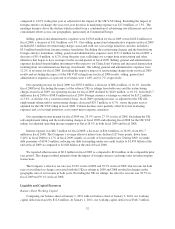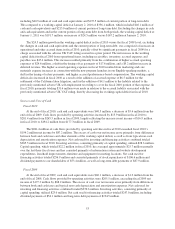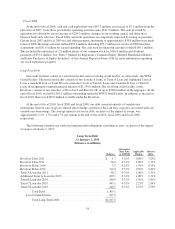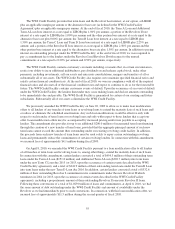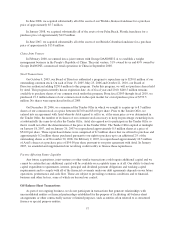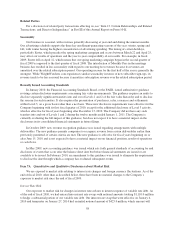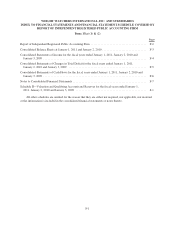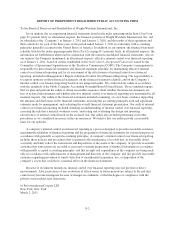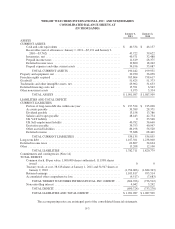WeightWatchers 2010 Annual Report Download - page 74
Download and view the complete annual report
Please find page 74 of the 2010 WeightWatchers annual report below. You can navigate through the pages in the report by either clicking on the pages listed below, or by using the keyword search tool below to find specific information within the annual report.R
elated Part
i
es
F
or a
di
scuss
i
on o
f
re
l
ate
d
part
y
transact
i
ons a
ff
ect
i
n
g
us, see “Item 13. Certa
i
nRe
l
at
i
ons
hi
ps an
d
Re
l
ate
d
T
ransact
i
ons, an
d
D
i
rector In
d
epen
d
ence”
i
n Part III o
f
t
hi
s Annua
l
Report on Form 10-K
.
S
easonality
Our business is seasonal, with revenues generally decreasing at year end and during the summer months
.
Our advertising schedule supports the three key enrollment-generating seasons of the year: winter, spring and
f
all, with winter having the highest concentration of advertising spending. The timing of certain holidays,
p
articularly Easter, which precedes the spring marketing campaign and occurs between March 22 and April 2
5
,
may affect our results of operations and the year-to-year comparability of our results. For example, in fisca
l
2009, Easter fell on April 12, which means that our spring marketing campaign began in the second quarter o
f
f
iscal 2009 as opposed to the first quarter of fiscal 2008. The introduction of Monthly Pass in the meetings
business has resulted in less seasonality with regard to our meeting fee revenues because its revenues are
amortized over the related subscription period. Our operating income for the first half of the year is generally th
e
strongest. While WeightWatchers.com experiences similar seasonality in terms of new subscriber sign-ups, its
r
evenue tends to be less seasonal because it amortizes subscri
p
tion revenue over the related subscri
p
tion
p
eriod
.
R
ecently Issued Accountin
g
Standard
s
I
n January 2010, t
h
eF
i
nanc
i
a
l
Account
i
ng Stan
d
ar
d
s Boar
d
,ort
h
e FASB,
i
ssue
d
aut
h
or
i
tat
i
ve gu
id
ance
r
ev
i
s
i
ng certa
i
n
di
sc
l
osure requ
i
rements concern
i
ng
f
a
i
rva
l
ue measurements. T
h
egu
id
ance requ
i
res an ent
i
ty t
o
di
sc
l
ose separate
l
ys
i
gn
ifi
cant trans
f
ers
i
nto an
d
out o
f
Leve
l
s1an
d
2o
f
t
h
e
f
a
i
rva
l
ue
hi
erarc
h
yan
d
to
di
sc
l
os
e
t
h
e reasons
f
or suc
h
trans
f
ers. It a
l
so requ
i
res t
h
e presentat
i
on o
f
purc
h
ases, sa
l
es,
i
ssuances an
d
sett
l
ement
s
w
i
t
hi
n Leve
l
3, on a gross
b
as
i
s rat
h
er t
h
an a net
b
as
i
s. T
h
ese new
di
sc
l
osure requ
i
rements were e
ff
ect
i
ve
f
or t
he
Company
b
eg
i
nn
i
ng w
i
t
hi
ts
fi
rst
fi
sca
l
quarter o
f
2010, except
f
or t
h
ea
ddi
t
i
ona
ldi
sc
l
osure o
f
Leve
l
3 act
i
v
i
ty
,
which is effective for fiscal years beginning after December 1
5
, 2010. The Company did not have any such
trans
f
ers
i
nto an
d
out o
f
Leve
l
s1an
d
2
d
ur
i
ng t
h
e twe
l
ve mont
h
sen
d
e
d
January 1, 2011. T
h
e Company
i
s
current
l
y eva
l
uat
i
ng t
h
e
f
u
ll i
mpact o
f
t
hi
sgu
id
ance,
b
ut
d
oes not expect
i
tto
h
ave a mater
i
a
li
mpact on t
he
di
sc
l
osures
i
n
i
ts conso
lid
ate
dfi
nanc
i
a
l
statements
i
n
f
uture
fili
ngs
.
I
n Octo
b
er 2009, new revenue reco
g
n
i
t
i
on
g
u
id
ance was
i
ssue
d
re
g
ar
di
n
g
arran
g
ements w
i
t
h
mu
l
t
i
p
l
e
d
e
li
vera
bl
es. T
h
e new
g
u
id
ance perm
i
ts compan
i
es to reco
g
n
i
ze revenue
f
rom certa
i
n
d
e
li
vera
bl
es ear
li
er t
h
an
p
rev
i
ous
ly
perm
i
tte
d
,
if
certa
i
ncr
i
ter
i
a are met. T
h
e new
g
u
id
ance
i
se
ff
ect
i
ve
f
or
fi
sca
ly
ears
b
e
gi
nn
i
n
g
on o
r
after June 15, 2010 and is not expected to have a material impact on our financial position, results of operations
o
r cas
hfl
o
w
s
.
I
n May 2009, new accounting guidance was issued which sets forth general standards of accounting for an
d
disclosure of events that occur after the balance sheet date but before financial statements are issued or are
available to be issued. In February 2010, an amendment to this guidance was issued to eliminate the requiremen
t
to disclose the date through which a company has evaluated subsequent events
.
I
tem 7A.
Q
uantitative and
Q
ualitative Disclosures about Market Risk
We are expose
d
to mar
k
et r
i
s
k
sre
l
at
i
ng to
i
nterest rate c
h
anges an
df
ore
i
gn currency
fl
uctuat
i
ons. As o
f
t
h
e
en
d
o
ffi
sca
l
2010, ot
h
er t
h
an as
d
escr
ib
e
db
e
l
ow, t
h
ere
h
ave
b
een no mater
i
a
l
c
h
anges to t
h
e Company’s
exposure to mar
k
et r
i
s
k
s
i
nce t
h
een
d
o
ffi
sca
l
2009.
Intere
s
t Rate Ri
s
k
Our exposure to market risk for chan
g
es in interest rates relates to interest expense of variable rate debt. As
o
f the end of fiscal 2010, we had entered into interest rate swaps with notional amounts totalin
g
$1,110.0 millio
n
to hed
g
e a substantial portion of our variable rate debt. Our interest rate swap that went effective on Januar
y
4,
2010 and terminates on Januar
y
27, 2014 had an initial notional amount of $425.0 million, which amount will
58


